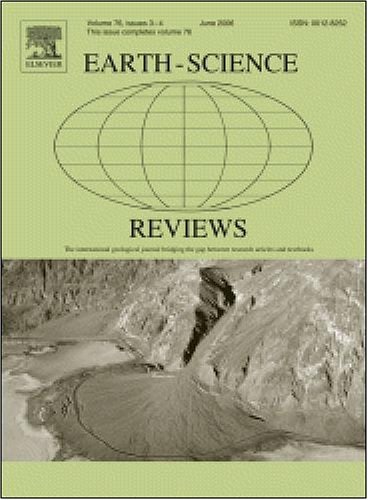Tectonics vs eustasy: The oceanic container and its contents
IF 10
1区 地球科学
Q1 GEOSCIENCES, MULTIDISCIPLINARY
引用次数: 0
Abstract
Sea-level change over Earth's history reflects the interplay of water volume and the ever-shifting architecture of ocean basins. While short-term fluctuations (103–105 yr) often trace the advance and retreat of glaciers and ice caps, multi-million-year trends (107–109 yr) arise from deep-Earth processes – seafloor spreading, subduction, intraplate deformation, mantle plume upwelling, and the emplacement of large igneous provinces – that remodel basin volume and modulate the ocean's water budget. New geodynamic models now discard the assumption of steady-state mantle regassing and degassing, showing instead that persistent imbalances can lock water into the interior or release it back to the surface, sculpting long-term sea-level trajectories.
Recent advances in seismic and tomographic imaging, coupled with high-resolution numerical simulations, have fostered an emerging convergence between geodynamic theory and stratigraphic records of Phanerozoic sea-level curves – particularly for second-order (multi-million years) Meso-Cenozoic variations. These efforts also cast doubt on earlier reconstructions based solely on continental flooding metrics without accounting for evolving hypsometries. Superimposed on these tectonic signals are third-order cycles driven largely by Earth's orbital rhythms: long-period Milankovitch modulations (∼1.2 Myr obliquity, especially common during refrigerations, and ∼2.4 Myr eccentricity, recurrent during warm intervals) leave clear imprints in sequence stratigraphic, deep-sea hiatuses, fossil diversity patterns, and stable-isotopic records. Meanwhile, the capacity of small, hydrous mantle plumes to shuttle water across the core-mantle boundary – and the topographic uplift associated with flood basalt provinces – emerges as an underappreciated influence on regional sea-level anomalies. Despite these advances, reconstructing pre-Cretaceous sea-level history remains hampered by scant constraints on ancient spreading and subduction systems. Addressing these gaps and achieving further advancements demands enhanced temporal resolution and more complete datasets – especially for younger intervals where the oceanic lithosphere is preserved with greater fidelity. Seismic and tomographic surveys in under-sampled regions, such as Africa, South America and West Antarctica, are especially critical. Legacy industry data could help fill key gaps, and broader access to publicly funded datasets is vital. Sea-level change stands as one of the most societally-relevant challenges in geoscience and meeting its demands will require sustained investment in advanced data collection, robust modeling, and collaborative partnerships between academia and industry.
构造学与海洋运动:海洋容器及其内容物
地球历史上海平面的变化反映了水量和不断变化的海洋盆地结构之间的相互作用。虽然短期波动(103-105年)经常追踪冰川和冰帽的前进和后退,但数百万年的趋势(107-109年)源于地球深处的过程——海底扩张、俯冲、板内变形、地幔柱上涌和大型火成岩省的侵位——这些过程重塑了盆地的体积并调节了海洋的水预算。新的地球动力学模型现在放弃了地幔稳态再排放和脱气的假设,而是表明持续的不平衡可以将水锁在内部或将其释放回表面,从而塑造出长期的海平面轨迹。地震和层析成像的最新进展,加上高分辨率的数值模拟,促进了地球动力学理论与显生宙海平面曲线地层记录之间的融合,特别是对于二阶(数百万年)中新生代的变化。这些努力也使人们对早期仅基于大陆洪水指标而不考虑不断变化的假设的重建产生了怀疑。叠加在这些构造信号上的是主要由地球轨道节律驱动的三阶旋回:长周期米兰科维奇调节(~ 1.2 Myr倾角,特别是在制冷期间常见,以及~ 2.4 Myr偏心率,在温暖间隔期间反复出现)在层序地层、深海断裂、化石多样性模式和稳定同位素记录中留下了清晰的印记。同时,小的、含水的地幔柱将水穿过核幔边界的能力——以及与洪水玄武岩省相关的地形隆起——对区域海平面异常的影响被低估了。尽管取得了这些进展,但重建白垩纪前的海平面历史仍然受到古代扩张和俯冲系统的限制。解决这些差距并取得进一步进展需要提高时间分辨率和更完整的数据集-特别是对于海洋岩石圈保存得更保真的较年轻的间隔。在非洲、南美洲和南极洲西部等取样不足的地区进行地震和层析成像调查尤其重要。遗留的行业数据可以帮助填补关键空白,更广泛地访问公共资助的数据集至关重要。海平面变化是地球科学中最具社会相关性的挑战之一,满足其需求将需要持续投资于先进的数据收集、强大的建模以及学术界和工业界之间的合作伙伴关系。
本文章由计算机程序翻译,如有差异,请以英文原文为准。
求助全文
约1分钟内获得全文
求助全文
来源期刊

Earth-Science Reviews
地学-地球科学综合
CiteScore
21.70
自引率
5.80%
发文量
294
审稿时长
15.1 weeks
期刊介绍:
Covering a much wider field than the usual specialist journals, Earth Science Reviews publishes review articles dealing with all aspects of Earth Sciences, and is an important vehicle for allowing readers to see their particular interest related to the Earth Sciences as a whole.
 求助内容:
求助内容: 应助结果提醒方式:
应助结果提醒方式:


